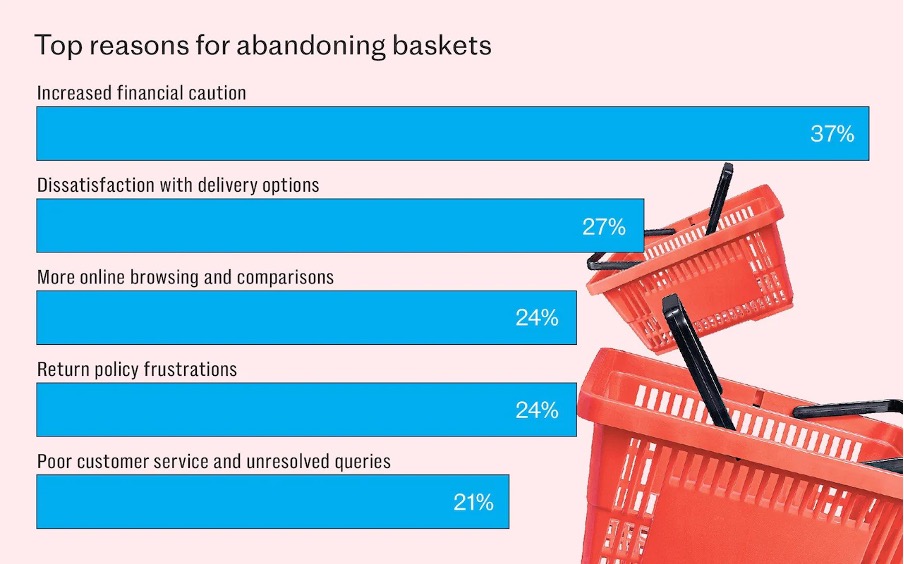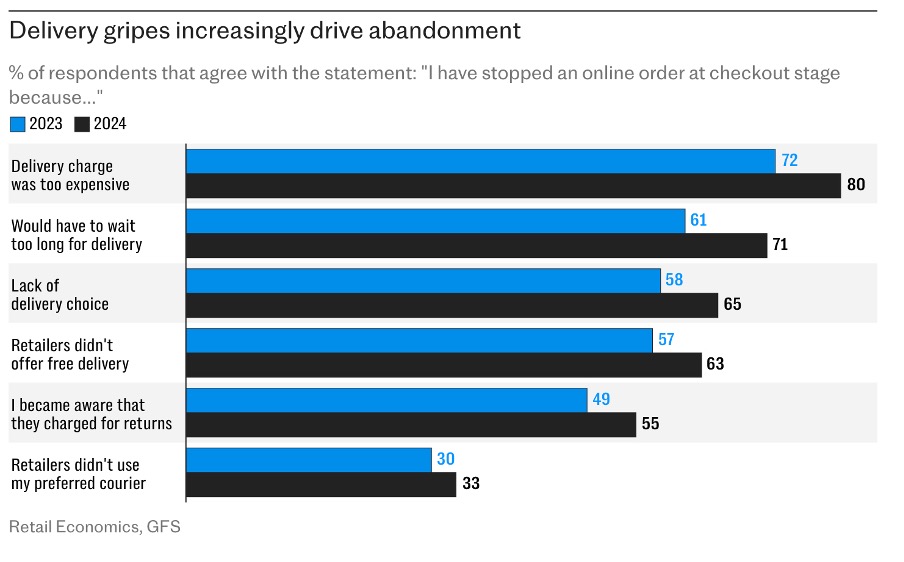Rising delivery fees and a resurgent high street are making online buyers think twice

When Martin Burkitt received the first email from online retailer LightInTheBox early last November, he barely took any notice of it.
Having browsed the clothing website earlier in the day and leaving a handful of Christmas gifts in his basket, he was not surprised to hear from the company with a simple welcome message.
He was, however, surprised with how persistent the emails quickly became.
“I got another one the next morning, asking if I’d had difficulties checking out,” Burkitt says. “And then, another, the following morning.”
All in all, he says LightInTheBox sent him 16 emails in three days, nudging him to complete his order.
Still, while LightInTheBox “lost their minds” sending a series of voucher codes and reminders, it was not enough to convince him.
“There was nothing they were offering to make up for the £30 delivery fees on around £90 worth of stuff,” Burkitt says. It was why he had not placed the order in the first place.
Burkitt is among the many British shoppers who are ditching their digital baskets mid-order, posing a headache for online retailers who are already facing pressure from the resurgent high street.
According to figures from Retail Economics and GFS, last year there was a 9pc increase in so-called “basket abandonment” last year, equal to around £3bn of lost sales.

In total, online retailers missed out on £34.4bn worth of sales in 2023, with shoppers citing high delivery costs, limited shipping options and new returns fees as the reasons why they scrapped their order.
It is only the second year that Retail Economics and GFS have gathered the data, but earlier studies suggest the practice has been increasing sharply. A report from Barclaycard in 2018 found that online stores were missing out on just £18bn of lost orders from shoppers abandoning baskets.
The jump since then will be partly down to higher spending online overall, as well as inflation, meaning more will naturally be left in baskets.
But this does not account for the steepness of the increase. While official figures suggest online sales have risen around 79pc since 2018, basket abandonment rates are climbing more sharply and appear to be up 92pc.
Richard Lim, chief executive at Retail Economics, says the current economic climate is partly to blame for more people deciding not to buy things they have put in their virtual baskets. The report found that much of the recent rise in basket abandonment has been among middle and high income millennials.
Generally, Lim says you would expect younger shoppers to be the most digitally-savvy and shop around across multiple retailers simultaneously. It is true that Gen Z are the biggest basket abandoners.
However, he says increasingly, online retailers are also struggling to get millennials to commit. According to the Retail Economics’ figures, people aged between 25 and 34 are over three times more likely to give up on baskets of clothes and shoes than those over 65. They are twice as likely to put furniture in their online baskets but not buy it as people aged between 55 and 64.
“This will partly be down to the second wave of the cost-of-living crisis,” Lim says. These so-called aspirational millennials “probably bought their first house in the last 10-12 years, they might have cars on contract and they’re only used to ultra-low interest rates”.

With borrowing costs having ballooned, Lim says this group – who have up until this point formed a significant portion of online retailers’ customer base – is now facing a particular crunch.
What this means is that they are more cautious on spending than they have been in years – and, increasingly, more sensitive to the higher costs at the checkout.
Delivery and admin fees have been slowly creeping up. In 2021, as inflationary pressures ramped up and shipping routes faced disruption, retailers began to quietly raise checkout costs.
Many have started introducing higher minimum spend fees for free delivery. Others have simply increased costs outright. British retail giant Next, for example, was charging £3.99 to deliver to a customers’ home in May 2020, according to archive data, raising this to £4.50 in early 2021. It now charges £4.95 for the service.
At Argos, fast-track same day delivery for small items will cost shoppers £5.95, compared to £3.95 in 2021 and £4.95 in late 2022.
Alongside steeper fees for delivery, people are becoming aware that it is getting more expensive to send items back. A wave of fashion stores have brought in new fees for returning items with the aim of stopping people from over-ordering and returning clothes.
Oh Polly this week became the latest online retailer to clamp down on “repeat refunders”, saying it would be charging up to £8.99 for returns. Others including H&M and Zara have also brought in returns fees.
While this appears to be helping clamp down on serial returners, there are signs it could be having a knock-on effect on their wider pool of shoppers.
Active customer numbers across the online fast fashion retailers including Asos and Boohoo have tumbled over the past year.
They would argue the customers who have been lost are those who were constantly returning items. However, figures suggest the higher costs also mean that customers in general are more likely than ever to scrap an order rather than buying it.
According to Retail Economics and GFS, 55pc of people who abandoned baskets mid-order did so because they became aware that retailers charged for returns, up from 49pc last year. Eighty per cent said they did so because the delivery charge was too expensive.

Gillian Ridley Whittle, the former fashion director at Topshop, says that some shoppers have always filled up baskets they were not necessarily going to buy.
While at the former British fashion darling, she held focus groups with younger members of the team who “spent the whole week planning their outfits for the weekend, browsing sites, putting possible options into baskets, and then deciding later which ones to buy or not”.
But, Ridley Whittle – who now runs sustainable underwear brand Peachaus – says she can understand why people have started actually scrapping whole orders rather than whittling down basket sizes.
Customers, she says, are used to shopping with “such ease and speed” that it is not surprising that they will ditch orders if anything rankles when they get to the final checkout, including “hidden costs or pricing which then changes the value of a product”.
It is a balancing act that many retailers are having to face up against, as their own costs push higher and they try to secure more profitable orders. For the online retailers, the stakes are high as more shoppers drift back into high street stores.
“Now more than ever, with the softer consumer environment and rising competition, these stores can ill afford to let these potential sales slip through their fingers,” Lim says.
Still, for people like Burkitt, there is such a thing as too much persistence when it comes to getting shoppers to buy. Offer one reminder and perhaps a working voucher code, then Burkitt says he may have considered placing his order.
But, “if you’re emailing me five times a day, then it’s a no”, Burkitt says. “It’s just simply too much.”
Appeared on: Telegraph.co.uk





